Beach
Bluffs
Restoration
Project
The goal of the Beach Bluffs Restoration Project (BBRP) is to return a diverse community of native shrubs and wildflowers to the coastal bluffs along the Santa Monica Bay from Malaga Cove to Ballona Creek. The project will beautify the landscape, reduce erosion, and provide habitat for native wildlife, potentially including the endangered El Segundo blue butterfly.
This project began as a grassroots effort and now has the support of the cities of Redondo Beach and Torrance, Los Angeles County Department of Beaches and Harbors, Santa Monica Bay Restoration Commission, California Department of Fish and Game, United States Fish and Wildlife Service, and a number of state and federal elected officials.
The first major tasks of the
BBRP are to develop a Master Plan and to implement a pilot restoration
project on a two-acre, County-owned site in Redondo Beach. A generous
donation from the City of Redondo Beach,
an in-kind match from the Los
Angeles County Department of Beaches and Harbors,
and a grant of state bond monies, administered through the Santa
Monica Bay Restoration Commission, have funded this first phase.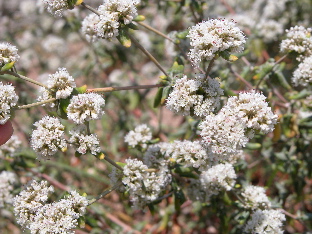 The Master Plan can be downloaded here.
The Master Plan can be downloaded here.
A volunteer committee of residents, conservationists, and city and county representatives directs the BBRP, with two local non-profit organizations — The Urban Wildlands Group and the Los Angeles Conservation Corps’ SEA Laboratory — providing scientific, technical, and logistical support.
WHY NATIVE PLANTS?
Native shrubs and wildflowers are adapted to southern California’s climate and therefore require little care. Their deep roots will do a better job stabilizing coastal bluffs than the shallow-rooted iceplant that is now abundant. Native plants will also attract a greater diversity of wildlife, and will help to provide potential habitat for the El Segundo blue butterfly and other native species.
The El Segundo blue butterfly is listed as an endangered species by the federal government. Its historic range included the dunes and bluffs from Ballona Creek to the Palos Verdes Peninsula. The creation of potential habitat for endangered species will be balanced with the public’s access and enjoyment of Los Angeles County beaches.
All plants will be grown specifically for the BBRP at a nursery in Redondo Beach established by The Urban Wildlands Group and the Los Angeles Conservation Corps’ SEA Laboratory.
LOCATION OF REVEGETATION SITES
The BBRP pilot restoration
project will be located on County land in Redondo Beach, between the Esplanade
and the beach. This site was chosen because of the strong support of local
elected officials and residents.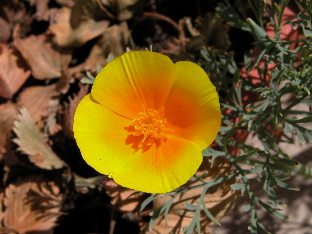
Another site will be revegetated nearby. While separate from the BBRP planning process, the Los Angeles County Department of Beaches and Harbors has incorporated native landscaping into the design of infrastructure improvements along the beach in Torrance (more info).
After completion of the Master Plan and pilot restoration project, additional funding will be sought to restore sites in other cities as identified by the plan.
The BBRP also may include improvements to infrastructure (e.g., sidewalks, parking areas, and trails) to enhance coastal access, alleviate traffic conflicts, and improve visitor experience. Such “hardscape” improvements will depend on separate funding sources, and will be designed and planned with public involvement and full cooperation with appropriate local jurisdictions.
TIMELINE
The Master Plan and pilot restoration project will be completed during 2003 and early 2004. The new plants will take several years to mature, at which time the El Segundo blue butterfly may be reintroduced. Further revegetation sites and infrastructure improvements will follow as funding allows.
PUBLIC EDUCATION
The BBRP will beautify the beach bluffs and help to bring back an endangered species, where possible. It will also serve to educate visitors about the history and ecology of the area. BBRP sites will include interpretive signs highlighting local natural history, restoration plantings, and local wildlife.
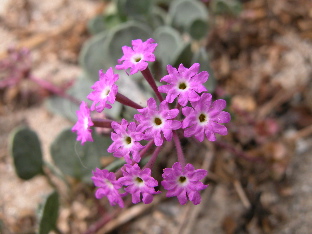 GET
INVOLVED
GET
INVOLVED
The BBRP offers an array of opportunities for community involvement. All steering committee meetings are open to the public. As the project progresses, volunteers will be needed to grow, plant, and care for the native vegetation.
Trained staff will provide assistance to voluneers at the revegetation site, in the native plant nursery, and at public education events. As the plants grow, so will the diversity of needs, both at the nursery and at the pilot revegetation site. Volunteers will monitor plant health, wildlife recruitment, and beachgoers’ attitudes about the program.
Any questions about the BBRP can be directed to SEA Lab Director Brent Scheiwe at bscheiwe@lacorps.org or on the web at http://www.lacorps.org.
The Beach Bluffs Restoration Project is a collaborative effort by local residents, City of Redondo Beach, Los Angeles Conservation Corps' SEA Laboratory, Los Angeles County Department of Beaches and Harbors, and The Urban Wildlands Group, with support from the Santa Monica Bay Restoration Commission.
UPDATES
July 2007 -- Project activities continue to receive attention from local and national medial. El Segundo blue butterfly has colonized dunes restored by the SEA Lab at Dockweiler State Beach (listen to a report on KPCC, RealPlayer required). Accounts of the return of the El Segundo blue butterfly to the bluffs of Torrance and Redondo Beach reached across California (see San Francisco Chronicle) and as far as the Boston Globe Chicago Tribune, and USA Today,
Here are a few photographs of the pilot project taken by Ann Dalkey.
Before restoration, with iceplant:
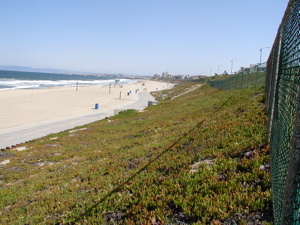
After restoration in April 2006:
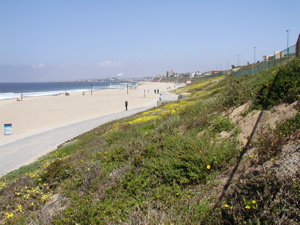
After driest winter in Los Angeles history, March 2007:
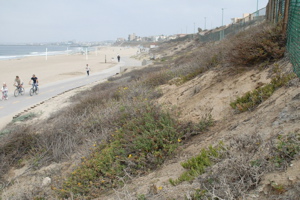
Photos of El Segundo blue butterfly by Ann Dalkey:
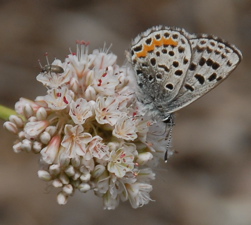
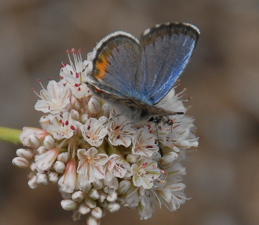
July 19, 2007. Columnist Paul Silva of The Beach Reporter offered a moving endorsement of the resurgence of the El Segundo blue butterfly.
July 9, 2007. The El Segundo blue butterfly has colonized habitat restored by the Beach Bluffs Restoration Project in Redondo Beach. Coverage started with the Los Angeles Times and continues with the Daily Breeze.
July 2006. The pilot project is profiled by the Society for Ecological Restoration International.
April 2006. The pilot project is profiled in the Daily Breeze. More coverage in The Beach Reporter. Pictures from our Earth Day event here.
Educational signage has been installed at the site in Redondo Beach. Best viewed with Adobe Acrobat (not Preview in Mac OS X).
- Why Native Plants?
- Plants in a Dune Environment
- Verbena or Iceplant?
- El Segundo Blue Butterfly and Dune Buckwheat
- Local Geology
- Native Arthropods
May 2005. The Master Plan is completed and available.Weeding and maintenance continues at the project site.
December 2004. Planting is complete in time for the winter rains. The rains were a bit much for the bluff at the southern end of the project site. Construction crews had removed the curb for the installation of an underground stormwater treatment device. During the storms of the last week of December, runoff from the Esplanade seems to have been focused onto the bluff at the construction site, which, combined with the excavation, resulted in a significant bluff slide and loss of our plantings. This was not caused by the new vegetation!
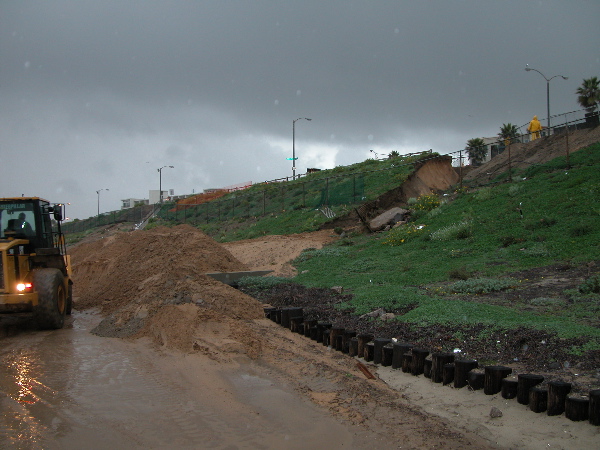
August 2004. Clearing of iceplant is almost complete, showing the total area that will be planted. Irrigation and plants have been installed for over half of this second area, while the plants continue to grow in the first section. A split rail fence will be constructed along the cleared area, as decided following a survey of beach users. Some of the new plants are in full flower, including abronia, beach evening primrose, and verbena (in order).
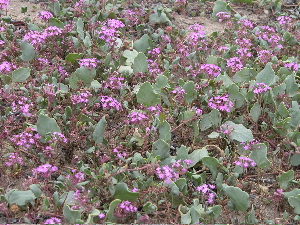
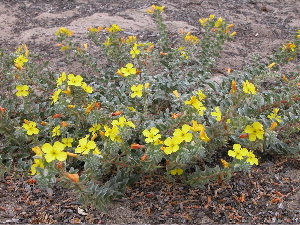
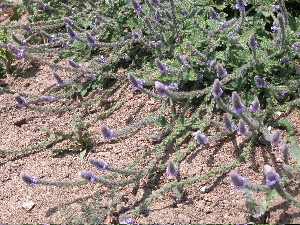
April 2004. The fence has been constructed along the section from Miramar Park to the first ramp. It has met with mixed reviews from the public, some appreciate it and others have expressed disapproval on various grounds. The BBRP participants will consider these opinions before continuing with the installation. For the first section, iceplant has been removed, irrigation installed, and container plants set in. Plants are spaced so that they will provide cover when mature, and consequently appear widely spaced now.
March 2004. Construction of a low split-rail fence along the top of the bluff north of Mirimar Park is scheduled to start in March. The fence will extend approximately 1,200 feet along the top of the bluff, roughly demarcating the property boundary between the City of Redondo Beach and the Los Angeles County Department of Beaches and Harbors. Iceplant removal and installation of native plants will follow. Field surveys and subcontracted reports for the Master Plan have been completed.
Frequently Asked Questions
Where did the El Segundo blue butterflies come from? It is a long way from El Segundo to Torrance.
The Torrance and Redondo Beach sites were colonized from a remnant population of El Segundo blue butterflies that lives about a quarter mile south of the Torrance site on private land along the Malaga Bluffs. They did not fly down the coast from El Segudo.
Why is it a surprise that El Segundo bue butterfly colonized the restorations at Torrance and Redondo Beach?
Research on the behavior of the butterfly in the 1980s described it as very sedentary, with the maximum distance traveled by adults around 200 feet. In colonizing the BBRP sites, the butterflies made it more than 1,000 feet.
Why do the plants look so brown right now?
Native plants are adapted to the summer drought. One of those adaptations is to lose some leaves. This effect is especialy visible this year because rainfall in winter 2006-2007 was the lowest in recorded history.
Won't the bluffs erode more if there is not complete plant cover?
While there may be some additional sand that blows around, the bare soil does not pose an erosion hazard. The roots of the native plants are far deeper than the iceplant ever was, and will consequently be much better at holding the bluff together. The Beach Bluffs Restoration Project Master Plan identified human foot-traffic down the bluffs as the single most important factor contributing to bluff erosion.
If you have more questions, send them to longcore [at] urbanwildlands.org.
Photographs © Travis Longcore